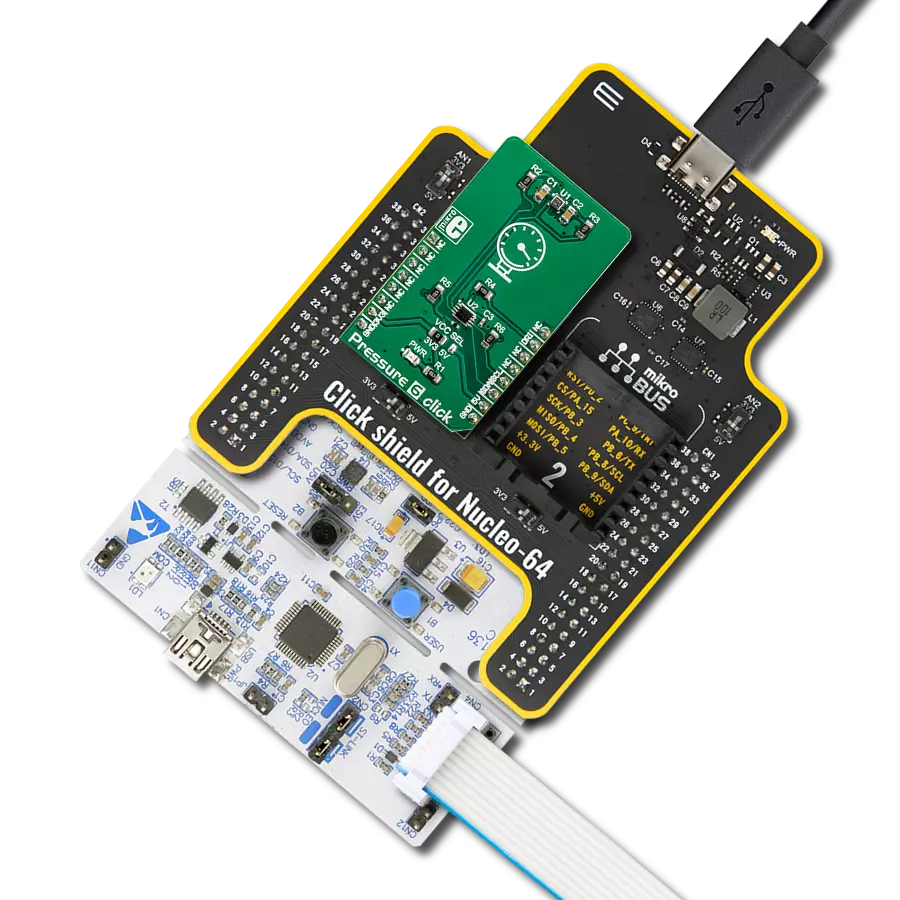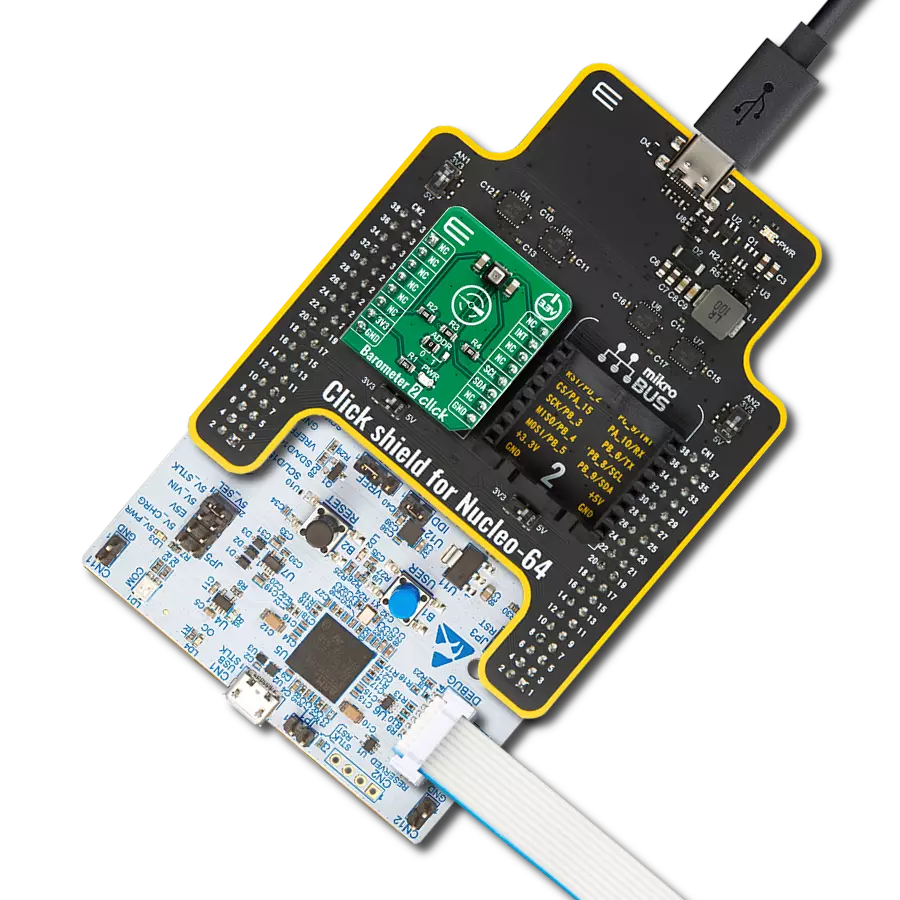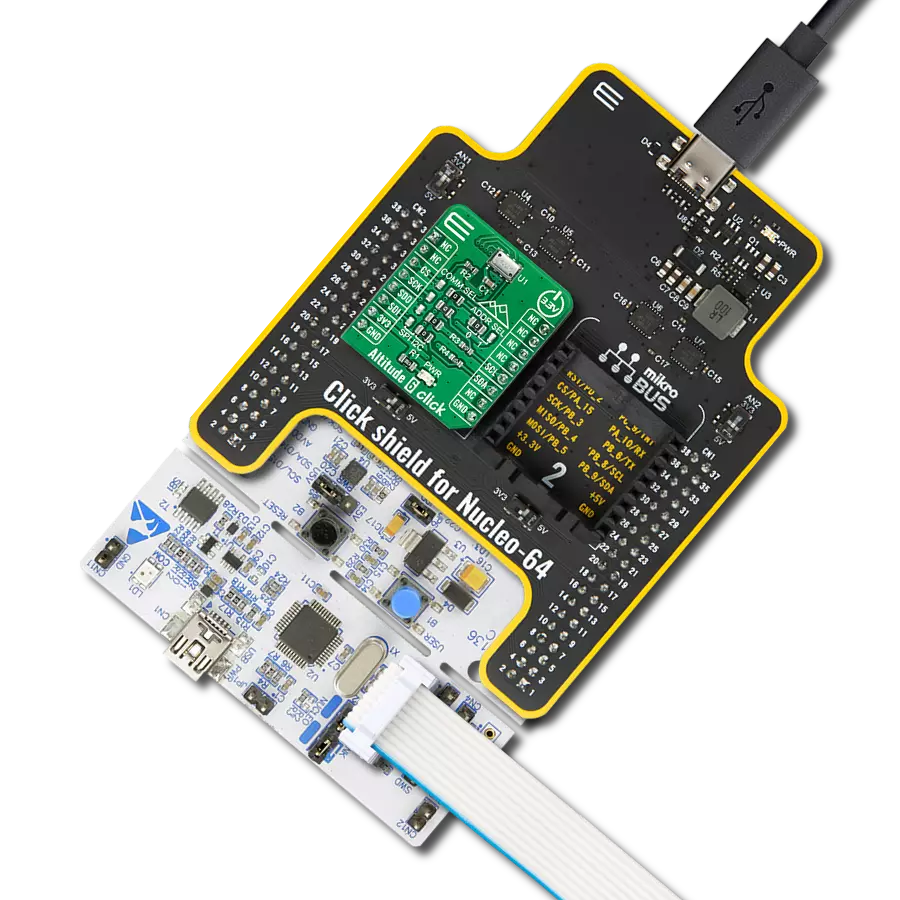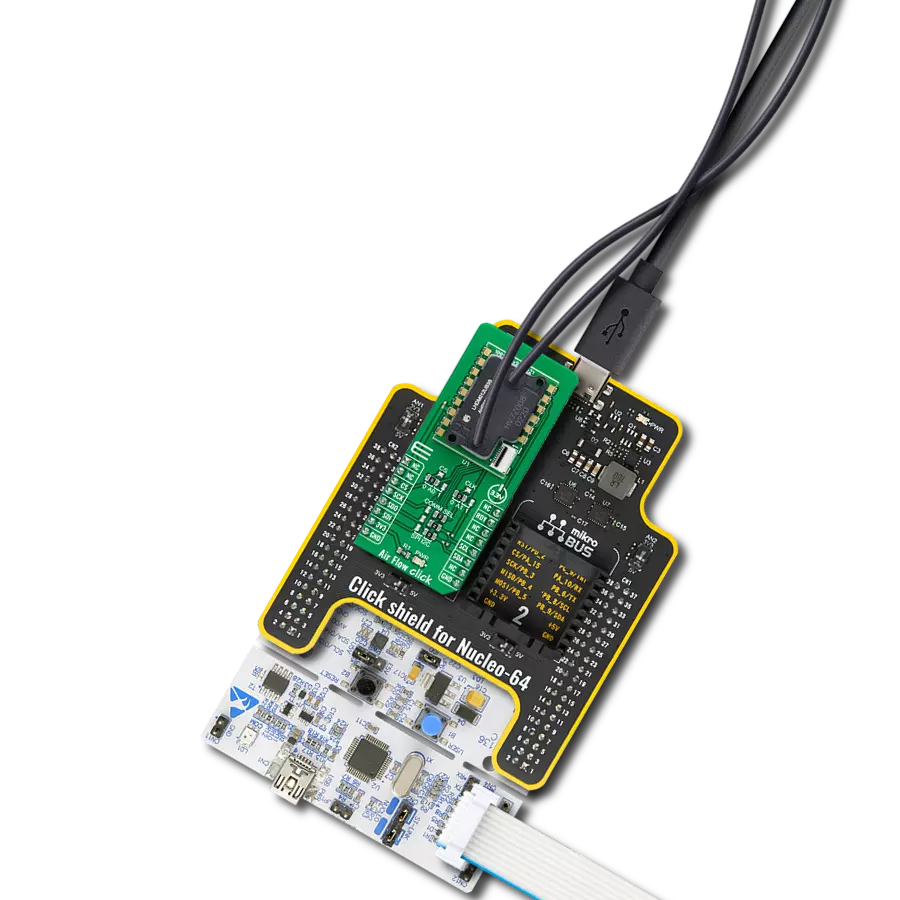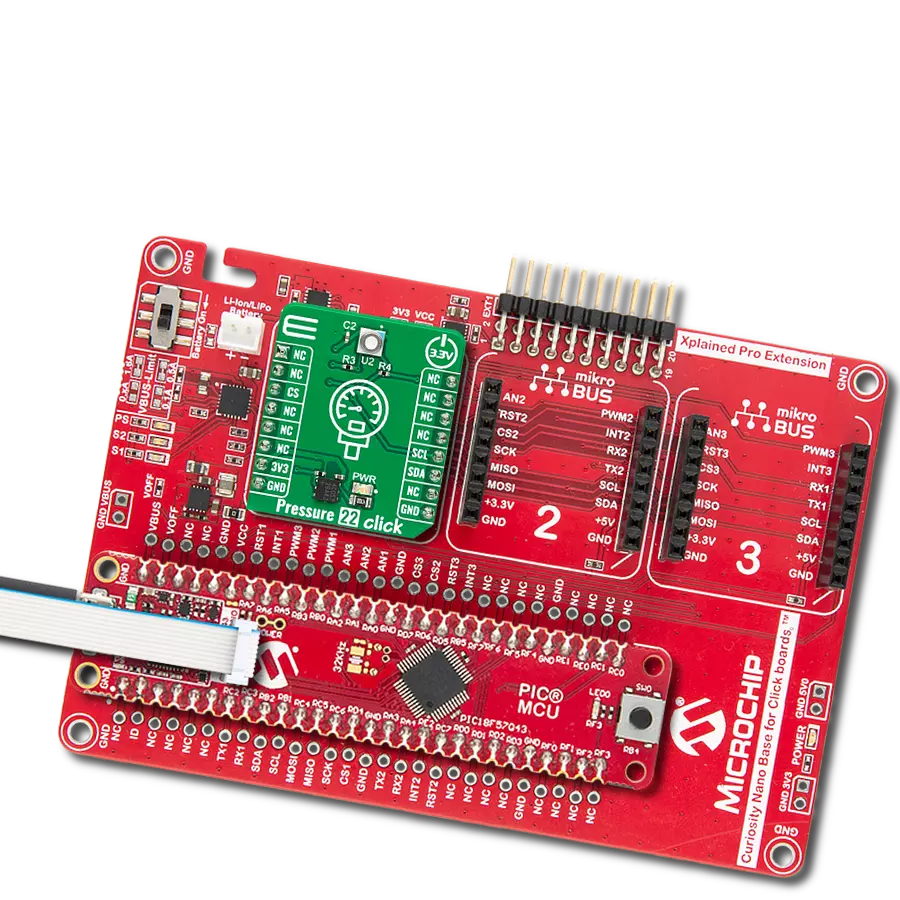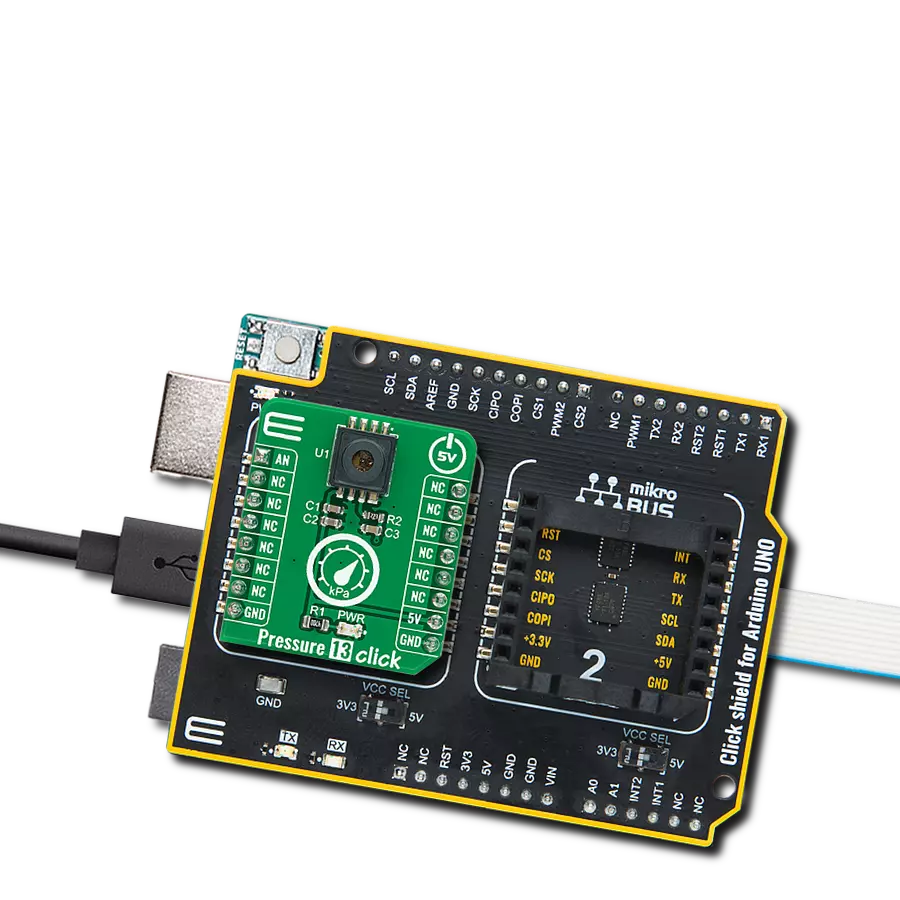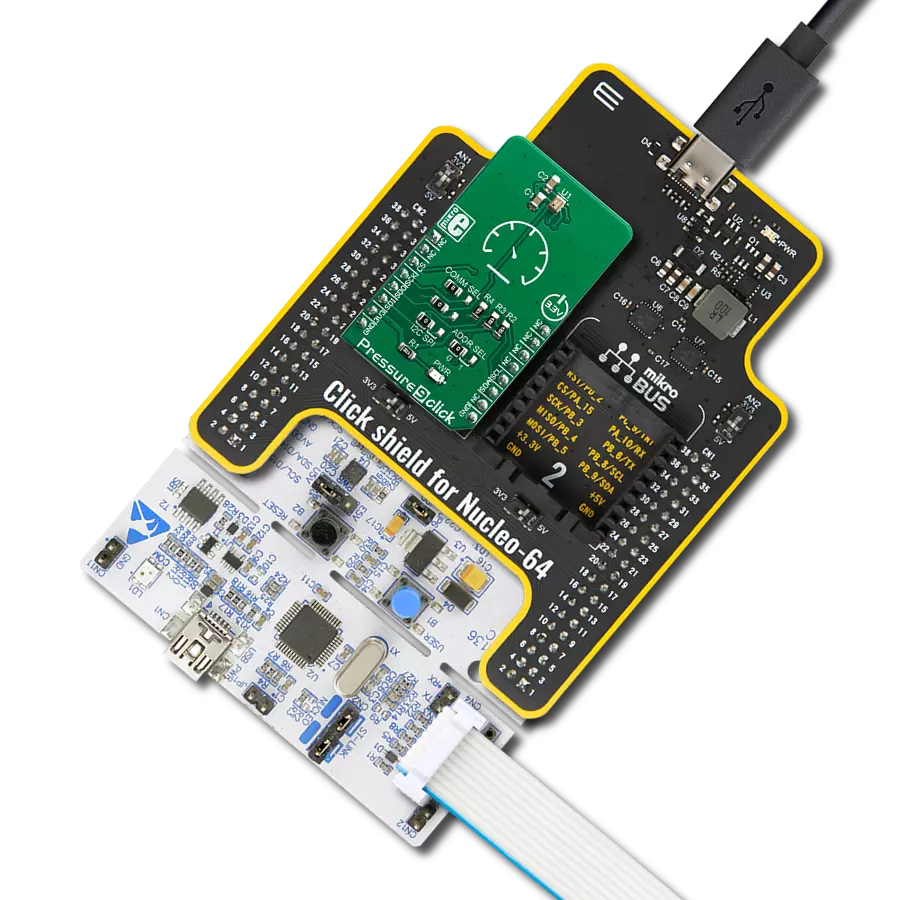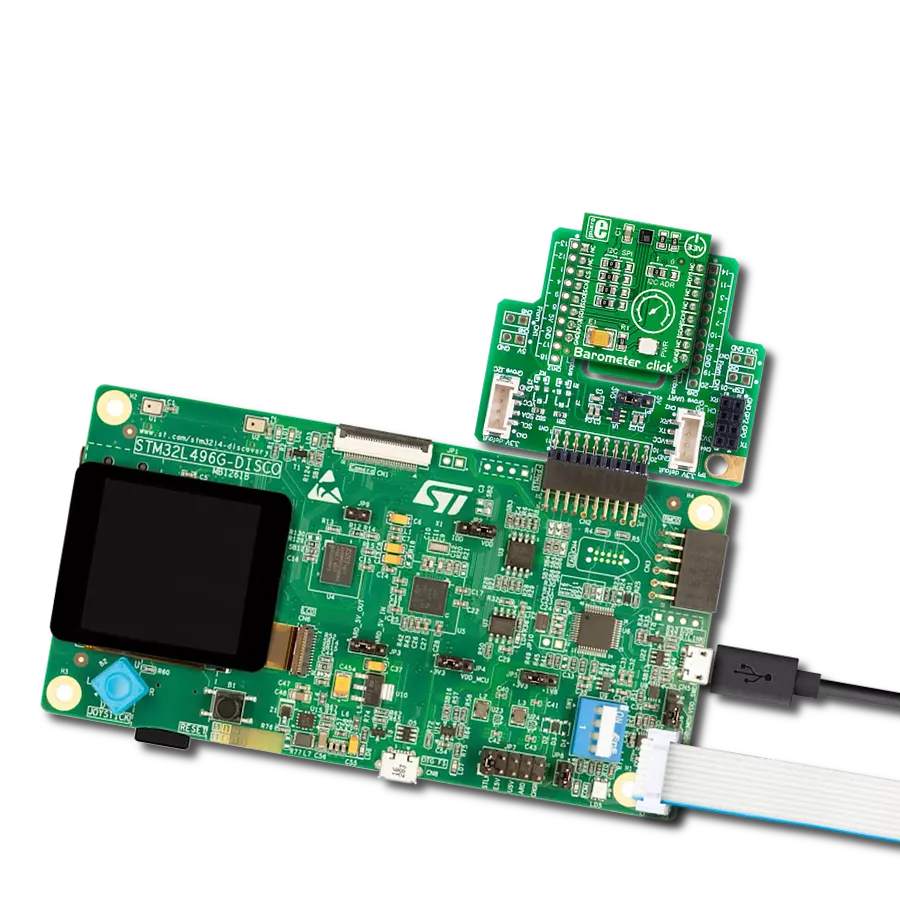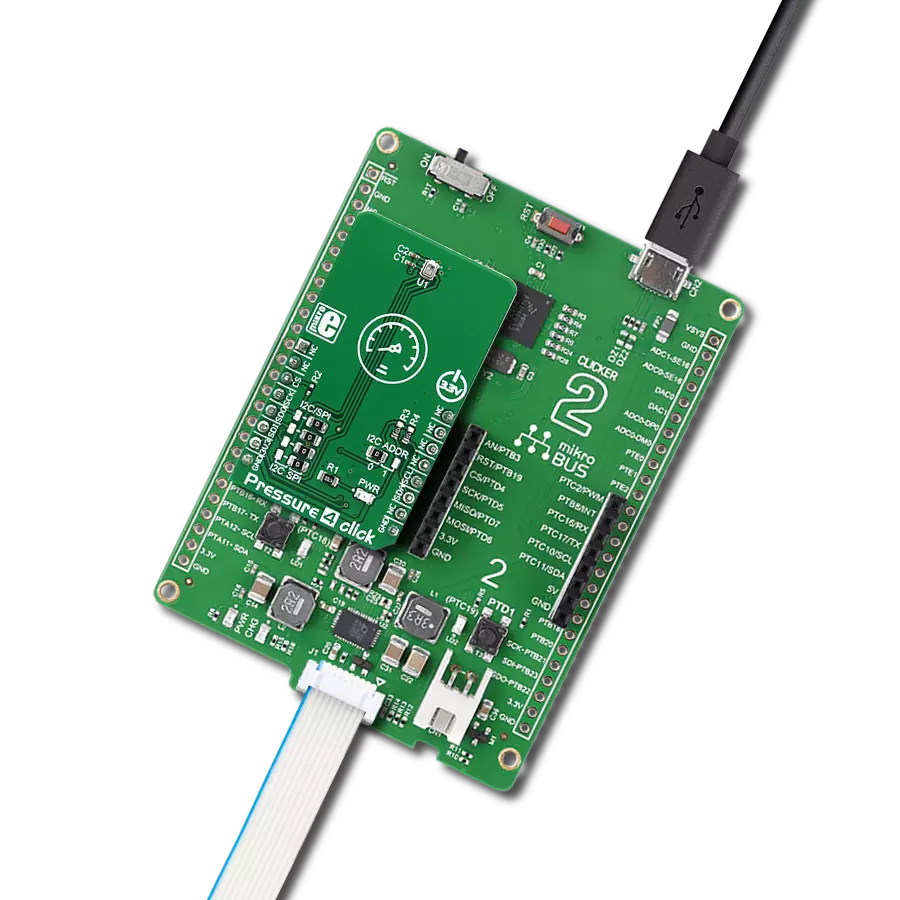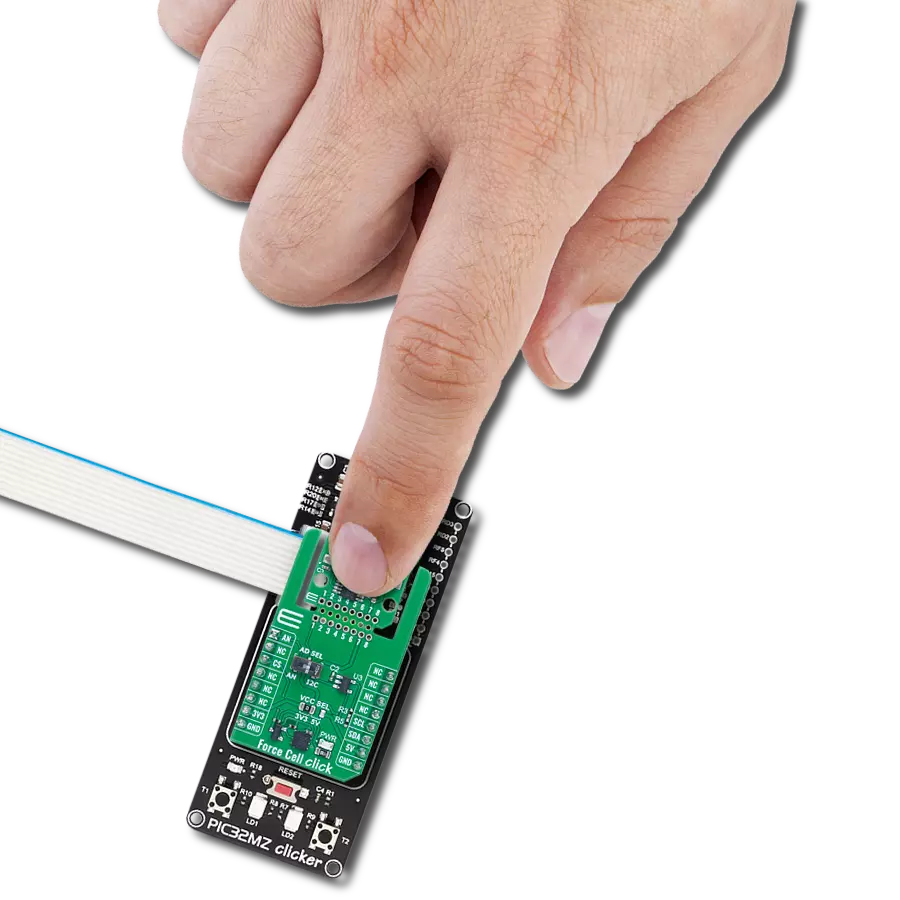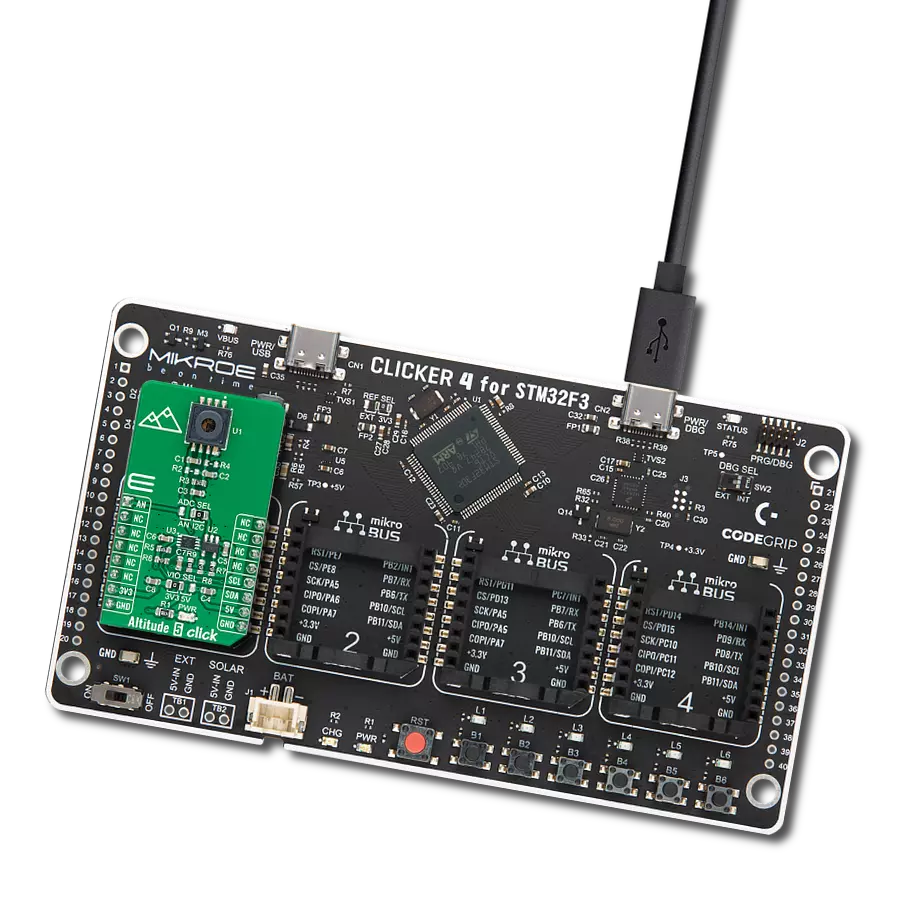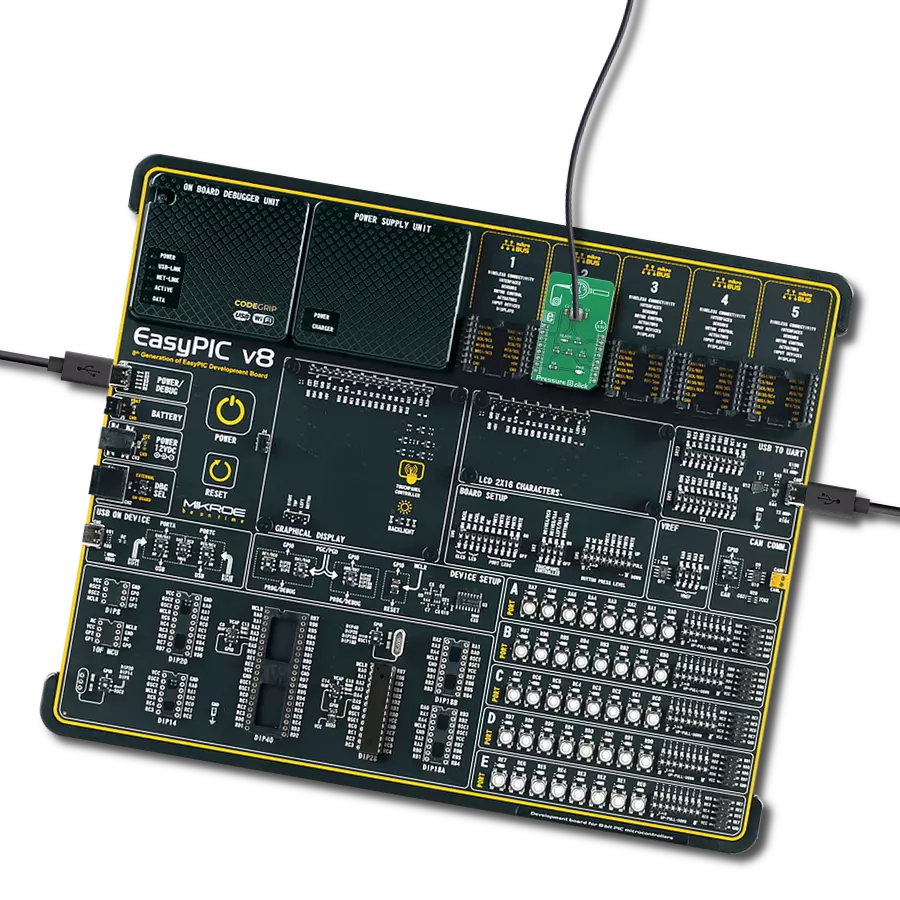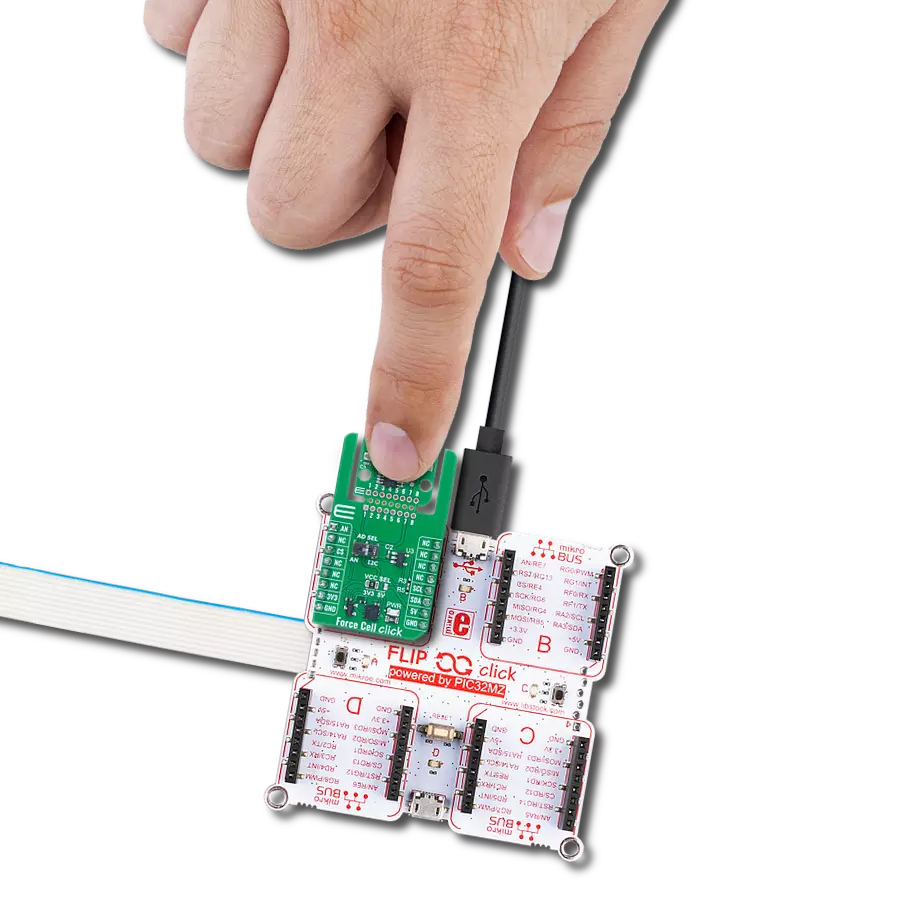From industrial processes to research breakthroughs, our digital pressure sensors are your gateway to unwavering precision and control
A
A
Hardware Overview
How does it work?
Pressure 6 Click is based on the BM1386GLV, a pressure sensor from ROHM Semiconductor. This is a highly integrated piezo-resistive absolute pressure sensor, with some advanced features, such as the thermal compensation of the pressure micro-electromechanical sensing element (MEMS), signal conditioning by the embedded IIR filtering section, and a FIFO buffer. The FIFO buffer has 32 slots for storing the data from both the thermal and the pressure sensor. The FIFO buffer can be disabled if the application needs to read the data directly. The interrupt pin DRI can be configured to alert the host MCU about the FIFO full buffer, FIFO watermark threshold exceeded event, and Data Ready event. The DRI is configured as an open-drain output pin, pulled up by a resistor on the Pressure 6 click. The presence of DRI pin allows more efficient firmware to be written, saving the host MCU from constantly having to poll the status register. The DRI pin is routed to the mikroBUS™ INT pin. The pressure
readings are stored in three pressure registers, while the temperature readings are stored in two thermal registers. The pressure data is 20 bits long, while the thermal data is 16 bits long. The same 16-bit A/D converter is used for both sensors, but the readings from the pressure sensor are further conditioned by the on-chip signal processing section. After the conversion interval is completed, the RD_DRDY bit will indicate that there is data ready for reading on the respective output registers. Once this bit has been read, it will be reverted to 0, waiting for a new conversion interval to be finished. The state of this bit can be redirected to the DRI pin, allowing an interrupt event to be triggered on a host MCU, whenever there is new data available. The conversion data is available over the I2C interface, as mentioned before. The I2C bus lines (SDA and SCL) are routed to the respective I2C mikroBUS™ pins which are pulled up by resistors on the Click board™ itself, allowing the Click board™ to be used right out of
the box. The datasheet of the BM1386GLV offers conversion formulas which can be used to convert the raw binary values from the respective registers to physical, human-readable format. However, Pressure 6 click comes with the library that contains functions which output properly formatted thermal and pressure readings. In addition to the BM1386GLV IC, Pressure 6 click incorporates an additional IC. It is the PCA9306, a well-known bi-directional I2C level translator from Texas Instruments, used on many different Click board™ designs, due to its simplicity and reliability. Since the BM1386GLV IC is limited to 3.3V operation, this IC allows it to be used with 5V too, expanding the connectivity of the Pressure 6 click to MCUs which use 5V levels for the I2C communication. The logic voltage level selection can be made by switching the small onboard SMD jumper labeled as VCC SEL, to a proper position (3V3 or 5V).
Features overview
Development board
Nucleo-64 with STM32F091RC MCU offers a cost-effective and adaptable platform for developers to explore new ideas and prototype their designs. This board harnesses the versatility of the STM32 microcontroller, enabling users to select the optimal balance of performance and power consumption for their projects. It accommodates the STM32 microcontroller in the LQFP64 package and includes essential components such as a user LED, which doubles as an ARDUINO® signal, alongside user and reset push-buttons, and a 32.768kHz crystal oscillator for precise timing operations. Designed with expansion and flexibility in mind, the Nucleo-64 board features an ARDUINO® Uno V3 expansion connector and ST morpho extension pin
headers, granting complete access to the STM32's I/Os for comprehensive project integration. Power supply options are adaptable, supporting ST-LINK USB VBUS or external power sources, ensuring adaptability in various development environments. The board also has an on-board ST-LINK debugger/programmer with USB re-enumeration capability, simplifying the programming and debugging process. Moreover, the board is designed to simplify advanced development with its external SMPS for efficient Vcore logic supply, support for USB Device full speed or USB SNK/UFP full speed, and built-in cryptographic features, enhancing both the power efficiency and security of projects. Additional connectivity is
provided through dedicated connectors for external SMPS experimentation, a USB connector for the ST-LINK, and a MIPI® debug connector, expanding the possibilities for hardware interfacing and experimentation. Developers will find extensive support through comprehensive free software libraries and examples, courtesy of the STM32Cube MCU Package. This, combined with compatibility with a wide array of Integrated Development Environments (IDEs), including IAR Embedded Workbench®, MDK-ARM, and STM32CubeIDE, ensures a smooth and efficient development experience, allowing users to fully leverage the capabilities of the Nucleo-64 board in their projects.
Microcontroller Overview
MCU Card / MCU
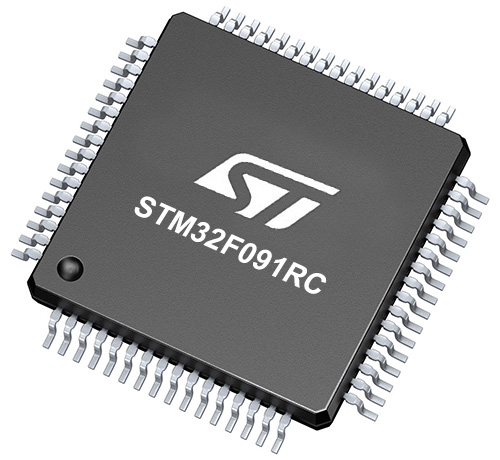
Architecture
ARM Cortex-M0
MCU Memory (KB)
256
Silicon Vendor
STMicroelectronics
Pin count
64
RAM (Bytes)
32768
You complete me!
Accessories
Click Shield for Nucleo-64 comes equipped with two proprietary mikroBUS™ sockets, allowing all the Click board™ devices to be interfaced with the STM32 Nucleo-64 board with no effort. This way, Mikroe allows its users to add any functionality from our ever-growing range of Click boards™, such as WiFi, GSM, GPS, Bluetooth, ZigBee, environmental sensors, LEDs, speech recognition, motor control, movement sensors, and many more. More than 1537 Click boards™, which can be stacked and integrated, are at your disposal. The STM32 Nucleo-64 boards are based on the microcontrollers in 64-pin packages, a 32-bit MCU with an ARM Cortex M4 processor operating at 84MHz, 512Kb Flash, and 96KB SRAM, divided into two regions where the top section represents the ST-Link/V2 debugger and programmer while the bottom section of the board is an actual development board. These boards are controlled and powered conveniently through a USB connection to program and efficiently debug the Nucleo-64 board out of the box, with an additional USB cable connected to the USB mini port on the board. Most of the STM32 microcontroller pins are brought to the IO pins on the left and right edge of the board, which are then connected to two existing mikroBUS™ sockets. This Click Shield also has several switches that perform functions such as selecting the logic levels of analog signals on mikroBUS™ sockets and selecting logic voltage levels of the mikroBUS™ sockets themselves. Besides, the user is offered the possibility of using any Click board™ with the help of existing bidirectional level-shifting voltage translators, regardless of whether the Click board™ operates at a 3.3V or 5V logic voltage level. Once you connect the STM32 Nucleo-64 board with our Click Shield for Nucleo-64, you can access hundreds of Click boards™, working with 3.3V or 5V logic voltage levels.
Used MCU Pins
mikroBUS™ mapper
Take a closer look
Click board™ Schematic

Step by step
Project assembly
Software Support
Library Description
This library contains API for Pressure 6 Click driver.
Key functions:
pressure6_get_temperature- This function gets the temperature data from the sensorpressure6_power_on- This function turns the sensor onpressure6_get_pressure- This function gets pressure data from the sensor
Open Source
Code example
The complete application code and a ready-to-use project are available through the NECTO Studio Package Manager for direct installation in the NECTO Studio. The application code can also be found on the MIKROE GitHub account.
/*!
* \file
* \brief Pressure6 Click example
*
* # Description
* This app returns the value of pressure on the sensor.
*
* The demo application is composed of two sections :
*
* ## Application Init
* Driver initialization and powering ON procedure to wake up the sensor and seting up the measurement mode.
*
* ## Application Task
* Read Pressure data and Temperature data and logs data to USBUART every 1 sec.
*
*
* \author MikroE Team
*
*/
// ------------------------------------------------------------------- INCLUDES
#include "board.h"
#include "log.h"
#include "pressure6.h"
// ------------------------------------------------------------------ VARIABLES
static pressure6_t pressure6;
static log_t logger;
static uint16_t pressure;
static uint16_t temperature;
// ------------------------------------------------------ APPLICATION FUNCTIONS
void application_init ( void )
{
log_cfg_t log_cfg;
pressure6_cfg_t cfg;
/**
* Logger initialization.
* Default baud rate: 115200
* Default log level: LOG_LEVEL_DEBUG
* @note If USB_UART_RX and USB_UART_TX
* are defined as HAL_PIN_NC, you will
* need to define them manually for log to work.
* See @b LOG_MAP_USB_UART macro definition for detailed explanation.
*/
LOG_MAP_USB_UART( log_cfg );
log_init( &logger, &log_cfg );
log_info( &logger, "---- Application Init ----" );
// Click initialization.
pressure6_cfg_setup( &cfg );
PRESSURE6_MAP_MIKROBUS( cfg, MIKROBUS_1 );
pressure6_init( &pressure6, &cfg );
pressure6_default_cfg( &pressure6 );
log_printf( &logger, "--- Start measurement ---\r\n" );
}
void application_task ( void )
{
// Task implementation.
pressure6_waiting_for_new_data( &pressure6 );
pressure = pressure6_get_pressure( &pressure6 );
temperature = pressure6_get_temperature( &pressure6 );
log_printf( &logger, "Pressure: %u\r\n", pressure);
log_printf( &logger, "Temperature: %u\r\n", temperature);
Delay_ms ( 1000 );
Delay_ms ( 1000 );
Delay_ms ( 1000 );
}
int main ( void )
{
/* Do not remove this line or clock might not be set correctly. */
#ifdef PREINIT_SUPPORTED
preinit();
#endif
application_init( );
for ( ; ; )
{
application_task( );
}
return 0;
}
// ------------------------------------------------------------------------ END
Additional Support
Resources
Category:Pressure
